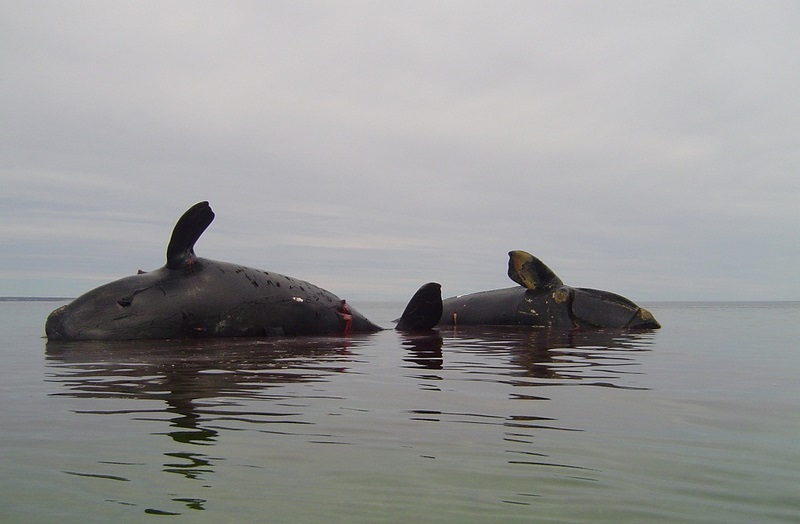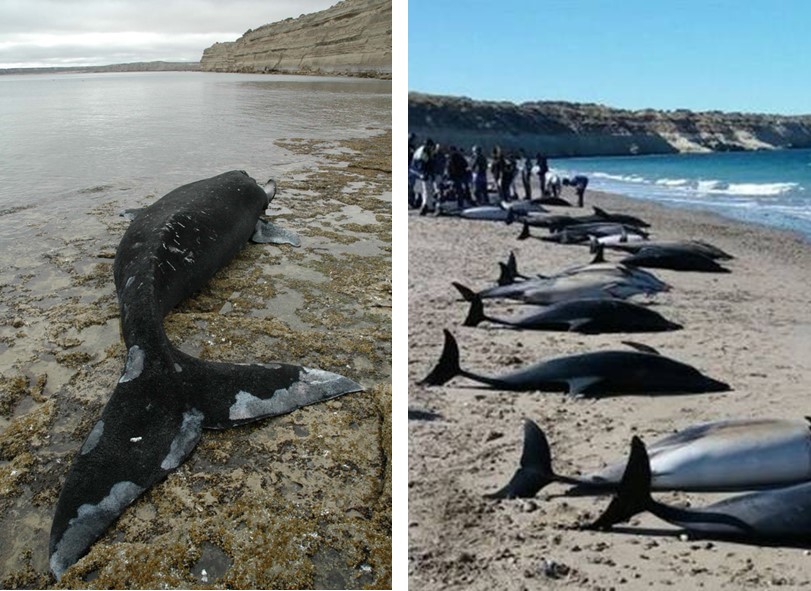By Alejandro Fernandez Ajo, PhD student in the Department of Biology, Northern Arizona University, visiting scientist in the GEMM Lab working on the gray whale physiology and ecology project
When a cetacean (whales and dolphins) is ashore or trapped in nearshore waters and cannot return to the open waters, it is considered stranded. Frequently, the stranded animal is in distress, dying, or dead. Although rare, the stranded cetacean can be a healthy animal trapped due to changes in tide or disorientation. Every year many cetacean strandings are reported from along the coasts around the world, and likely many more stranding events go unnoticed when they occur in remote areas. In all cases, the question is: why do cetaceans beach?

There may be different causes for whales and dolphins to strand on beaches, either dead or alive. Understanding and investigating the causes of cetaceans strandings is critical because they can be indicators of ocean health, can help identify anthropogenic sources of disturbance, and can give insights into larger environmental issues that may also have implications for human health (NOAA). In this context, when scientists are analyzing a stranding event, they consider both possibilities that the event was natural or human-caused and classify strandings according to specific characteristics to study the causes of these events.
Types of cetacean strandings:
Live or Dead Stranding:
A stranding can involve live animals or dead animals if the death occurs in the sea and the body is thrown ashore by wind or currents. In live strandings, when they occur near urbanized areas, usually significant efforts are made to rescue and return the animals to the water; with small odontocetes, sometimes there is success, and animals can be rescued. However, when large whales are beached alive, their own weight out of the water can compress their organs and can cause irreversible internal damage. Although not externally visible, such damage can sometimes cause the death of the animal even after returning to the sea.
According to the number of individuals:
Single strandings occur when only a single specimen is affected at the time. The cetaceans that most frequently strand individually are the baleen (or mysticete) whales, such as right and humpback whales, due to their often solitary habits.
Mass strandings comprise two or more specimens, and in some cases, it can involve tens or even a few hundred animals. The mass strandings are more frequently observed for the odontocetes, such as pilot whales, false killer whales, and sperm whales with more complex social structures and gregarious habits.

Unusual Mortality Events
The Marine Mammal Protection Act defines an unusual mortality event (UME) as a stranding event that is unexpected, involves a significant die-off of any marine mammal population, and demands immediate response. Seven criteria make a mortality event “unusual.” Source: https://www.fisheries.noaa.gov.
- A marked increase in the magnitude or a marked change in morbidity, mortality, or strandings when compared with prior records.
- A temporal change in morbidity, mortality, or strandings is occurring.
- A spatial change in morbidity, mortality, or strandings is occurring.
- The species, age, or sex composition of the affected animals is different than that of animals that are normally affected.
- Affected animals exhibit similar or unusual pathologic findings, behavior patterns, clinical signs, or general physical condition (e.g., blubber thickness).
- Potentially significant morbidity, mortality, or stranding is observed in species, stocks, or populations that are particularly vulnerable (e.g., listed as depleted, threatened, or endangered, or declining). For example, stranding of three or four right whales may be cause for great concern, whereas stranding of a similar number of fin whales may not.
- Morbidity is observed concurrent with or as part of an unexplained continual decline of a marine mammal population, stock, or species.
The purpose of the classification of a mortality event as a UME is to activate an emergency response that aims to minimize deaths, determine the event cause, or causes, determine the effect of the event on the population, and identify the role of environmental parameters in the event. Such classification authorizes a federal investigation that is led by the expertise of the Working Group on Marine Mammal Unusual Mortality Events to investigate the event. This working group is comprised of experts from scientific and academic institutions, conservation organizations, and state and federal agencies, all of whom work closely with stranding networks and have a wide variety of experience in biology, toxicology, pathology, ecology, and epidemiology.

What can be learned from strandings and UMEs?
Examining stranded marine mammals can provide valuable insight into marine mammal health and identify environmental factors leading to strandings. Through forensic examinations, the aim is to identify possible risks to whales’ health and evaluate their susceptibility to diseases, pollutants, and other stressors. This information can contribute to cetacean conservation through informed management strategies. However, the quality of the data derived from a necropsy (the postmortem examination of carcasses) is highly contingent upon how early the stranding event is reported. As soon as the animal is deceased, decomposition starts, hindering the possibilities of detailed investigations of the cause of death.
Therefore, a solid network that can report and respond quickly to a stranding event is fundamental; this includes trained personnel, infrastructure, funding, and expertise to respond in a manner that provides for animal welfare (in the case of live strandings) and obtains data on marine mammal health and causes of death. Moreover, a coordinated international organization that integrates national marine mammal stranding networks has also been identifying as a critical aspect to enable adequate response to such mortality events. In many locations and countries around the world, funding, logistical support, and training remain challenging to stranding response.
In response to these concerns and needs, at the last World Marine Mammal Conference, which took place in Barcelona in December of 2019, The Global Stranding Network was founded to “enhance and strengthen international collaboration to (1) ensure consistent, high-quality response to stranded marine mammals globally, and (2) support conservation efforts for species under threat of extinction.” Monitoring marine mammal health worldwide can guide conservation and help identify priority areas for management (Gulland and Stockin, 2020).
What to do in case of finding a whale or dolphin on the beach?
When strandings occur, it is essential to know how to act. Unfortunately, untrained people, often with good intentions, can worsen the situation of stress and injury to the animal or can put themselves at risk of injury or exposure to pathogens. If you find a cetacean alive or dead on the beach, the most important things to do are:
- Record information about the location and the animal´s characteristics (the species, if known; the animal’s approximate size; and status (alive or dead)).
- Give immediate notice to the responsible authorities so that specialized help arrives as soon as possible. Report a Stranded or Injured Marine Animal.
- Keep at a safe distance: the animal may appear dead to the naked eye and not be. It is important to remember that cetaceans are wild animals and that in stressful situations such as strandings, they can try to defend themselves.
- Do not touch the animal: one of the causes of strandings is diseases; therefore, it is advisable not to contact the individuals to avoid exposure to potential pathogens.
- If the animal is alive, keep a distance from the animal, especially from its head and tail. Prevent children or dogs from approaching the animal.
- Keep calm and do not make noise that could disturb the stranded animal.
- Do not take the animal out of the water if it is on the shore or return it to the sea if it is on the beach: Such movement could cause serious injuries, or even death.
- Do not feed the animal or give it water: keep the blowhole clear because it is where they breathe.
Source: Whale Conservation Institute of Argentina
Important contacts in case of reporting a Stranded or injured Marine Mammal:
References:
https://ballenas.org.ar/programa-de-monitoreo-sanitario-ballena-franca-austral-pmsbfa/
https://globalstrandingnetwork.com/about
Proceedings of the workshop “Harmonizing Global Stranding Response.” (2020) World marine mammal Conference Barcelona, Catalonia, Spain. Editors: Gulland F and Stockin K; Ecs Special Publication Series No. 62.
Mazzariol S., Siebert U., Scheinin A., Deaville R., Brownlow A., Uhart M.., Marcondes M., Hernandez G., Stimmelmayr R., Rowles T., Moore K., Gulland F., Meyer M., Grover D., Lindsay P., Chansue N., Stockin K. (2020). Summary of Unusual Cetaceans Strandings Events worldwide (2018-2020). SC-68B/E/09 Rev1.
